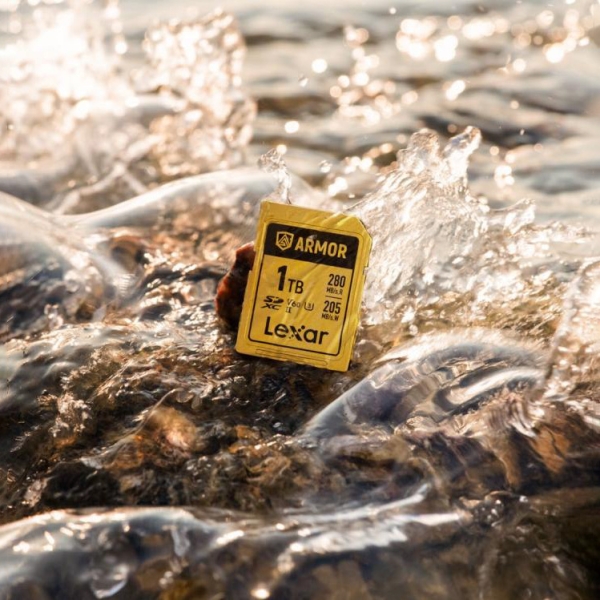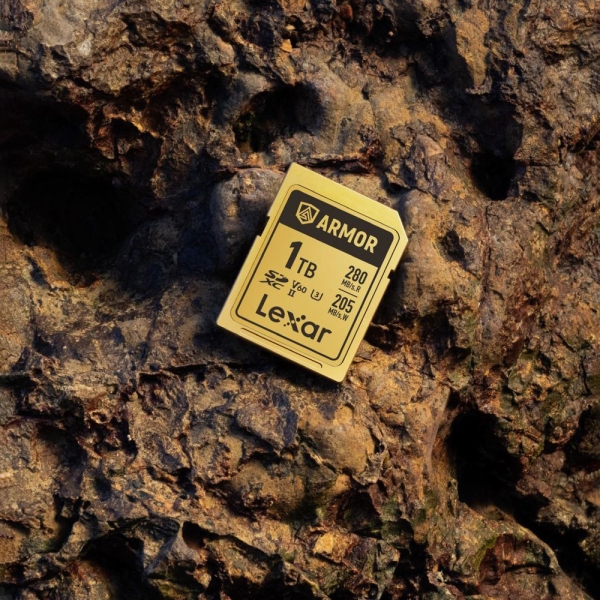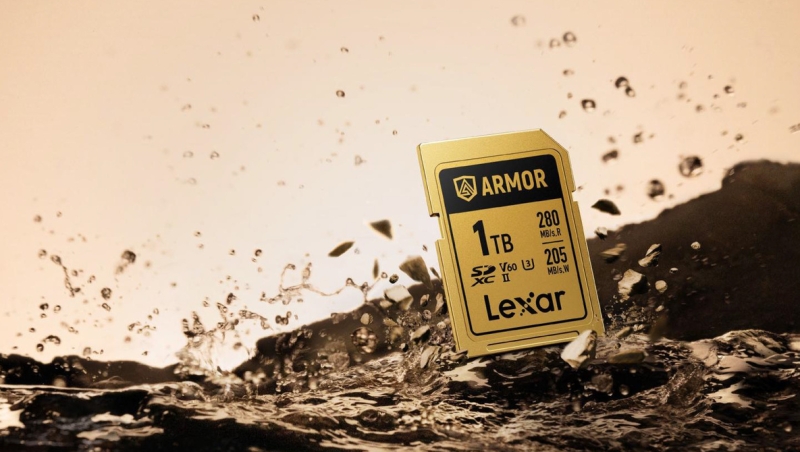Contents
The humble SD card might be one of the scariest points of failure for photographers. Consider your entire shoot stored on a fragile plastic wafer: what can you do to protect your images “in flight”? Lexar’s answer with the ARMOR GOLD is to ruggedize the SD card format to the max, armoring it in metal and eliminating points of failure. But does it still make for a good memory card?
This card is a novel take on a format with a long legacy, in a market that has been overwhelmingly focused on the singular pursuit of speed. While still very fast (Lexar’s second fastest SD card overall), the ARMOR GOLD’s primary mission is to be the toughest SD card you can buy. I have been shooting with the 1 TB version to find out if this focus on physical resilience is a gimmick or a genuinely important feature for working photographers and videographers.
Build and Design
The first thing you notice when you handle the ARMOR GOLD card is the construction. Instead of the typical plastic shell, Lexar has used stainless steel. The difference is immediate. It feels substantial and solid in a way no other SD card has—it feels instead like the metal-framed CFexpress Type A cards that some shooters might be familiar with. Importantly, it retains full compatibility with the SDXC format and behaves just like the regular SD card you’re used to using.

Lexar claims this metal shell has a pressure resistance of up to 370 N, which is apparently 37 times higher than a standard card. While I didn’t have a hydraulic press handy, I have no doubt it could withstand being stepped on, dropped, or even twisted in a way no plastic SD card could take.
This focus on durability extends beyond just the eye-catching metal casing. The card has an IP68 rating, meaning it is sealed against dust and can be submerged in water. For anyone who has ever shot in the rain, at a dusty location, or near the ocean, this provides a significant level of reassurance. It is also rated to withstand drops from over 16 feet and operate in extreme temperatures.
What I find particularly interesting, however, are the subtle design changes. Lexar removed the fragile plastic connector ribs and, most notably, the write-protect switch. These are two of the most common physical failure points on an SD card, and their removal is a smart design decision. This card has literally eliminated some of the ways a standard card can break. Of course, if you’re a fan of the write-protect switch, you will need to look elsewhere for your next card.
Specifications and Performance
While the headline feature is durability, this is still a high-performance UHS-II card. It is rated as V60, which guarantees a minimum sustained write speed of 60 MB/s. In my testing, it easily handled this, with Lexar advertising maximum write speeds of up to 205 MB/s and read speeds of up to 280 MB/s.

This level of performance is more than enough for the vast majority of creative work. I found it had no trouble recording 4K and 6K video streams without a single dropped frame. For photography, it kept up with long, high-speed continuous bursts from my camera, clearing the buffer efficiently. When it came time to offload files, the 280 MB/s read speed made for a quick and painless process.
This card is V60, however, not V90 like Lexar’s own 2000x line. This means it might not be the ideal choice for creatives shooting in high-bitrate 8K video formats. However, Sony users shooting 8K would be better served by a CFexpress Type A card anyway, in my opinion. But for nearly every other application, from high-resolution photography to 6K video, the ARMOR GOLD’s performance is rock solid.
Who Is This Card For?
The ARMOR GOLD is in a very specific and important niche. This is a card built for professionals who value peace of mind above all else. I see it as the perfect solution for adventure, travel, and wildlife photographers who are working in unpredictable and harsh environments. The protection against water, dust, and impact is a tangible benefit when you are far from home.

It is also an excellent choice for any creator who frequently handles their media in the field. Wedding and event shooters who swap cards multiple times a day and hand them off to assistants or second shooters will appreciate the robust build, as this card can better withstand the knocks and dings inherent to moving media around.
On the other hand, if you primarily shoot in a controlled studio environment and your cards make the safe, infrequent trip between your camera and your card reader over your desk, the enhanced durability might be overkill.
Value
That brings us to the main consideration for many potential buyers, which is the price. The Lexar ARMOR GOLD card carries a premium for its unique construction. You can find other cards with similar V60 performance levels, like Lexar’s own 1800x series, for a lower price.
The question you have to ask is what that extra cost gets you. You are not just paying for megabytes per second with this model; you are paying for peace of mind. For the right user, that is easily worth the premium, especially compared to the real financial or reputational risk of lost images. For a budget-conscious user who isn’t facing those environmental risks, a more traditional card (and a dual-slot system) might make more sense.
The Lexar 1 TB ARMOR GOLD UHS-II SDXC card represents what feels like a peak of SD card design. It takes this familiar, near-universal standard and reinforces it against all the common points of failure, all while maintaining excellent performance. It shows that there is still room for meaningful innovation in a product category we often take for granted. While its speed is not the absolute fastest on the market, its physical resilience is seemingly unmatched.
The Lexar ARMOR GOLD UHS-II SDXC is available for purchase in 128 GB, 256 GB, and 1 TB capacities.
What I Liked
-
Exceptional physical durability thanks to stainless steel design.
-
IP68 rating provides confidence in harsh conditions.
-
Simplified design with no write-protect switch eliminates common SD card failure points.
-
Strong V60 performance suitable for up to 6K video.
What Could Be Improved
-
The price premium is significant compared to other cards with similar performance.
-
Lack of a V90 rating may deter users with very high-bitrate 8K video needs.

